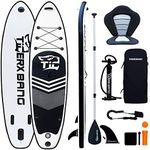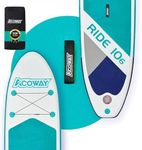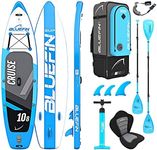Buying Guide for the Best Paddle Board For Kids
Choosing the right paddle board for kids involves considering their safety, comfort, and enjoyment. Kids' paddle boards are designed to be more stable and easier to handle, making it important to focus on features that enhance these aspects. Understanding the key specifications will help you select a board that matches your child's size, skill level, and intended use, ensuring a fun and safe experience on the water.Size and VolumeSize and volume are crucial for stability and ease of use. A paddle board's size is typically measured in length, width, and thickness, which together determine its volume. For kids, a shorter and wider board is often better as it provides more stability and is easier to maneuver. Boards around 8 to 10 feet in length are generally suitable for children. The volume should be enough to support the child's weight, with a bit of extra capacity for growth. Choose a board that matches your child's weight and height to ensure they can handle it comfortably.
Weight CapacityWeight capacity indicates how much weight a paddle board can support while maintaining stability and performance. It's important to choose a board with a weight capacity that exceeds your child's current weight to allow for growth and any additional gear they might carry. Boards with a weight capacity of 100 to 150 pounds are typically suitable for kids. Ensure the board can support your child without sinking or becoming unstable.
MaterialThe material of a paddle board affects its durability, weight, and performance. Most kids' paddle boards are made from either inflatable materials or solid foam. Inflatable boards are lightweight, easy to transport, and generally more forgiving if a child falls on them. Solid foam boards are more durable and provide a more stable ride but can be heavier. Consider where and how often the board will be used to decide which material is best for your child.
StabilityStability is key for beginners and younger paddlers to feel confident on the water. A board's stability is influenced by its width and shape. Wider boards offer more stability, making them ideal for kids who are just starting out. Look for boards with a width of at least 30 inches to ensure your child can balance easily. If your child is more experienced, they might be able to handle a slightly narrower board for better maneuverability.
Fin SetupThe fin setup on a paddle board affects its tracking and maneuverability. Most kids' boards come with a single fin or a tri-fin setup. A single fin is easier to manage and provides good tracking for straight-line paddling, which is ideal for beginners. A tri-fin setup offers more control and is better for turning, which might be suitable for more experienced young paddlers. Consider your child's skill level and the type of water they will be paddling in when choosing the fin setup.
Deck PadThe deck pad is the surface on which the paddler stands, and it should provide good grip and comfort. A soft, non-slip deck pad is essential for kids to prevent slipping and ensure a comfortable ride. Look for boards with a textured or grooved deck pad that offers good traction. This is especially important if the board will be used in wet conditions or if your child is new to paddle boarding.















